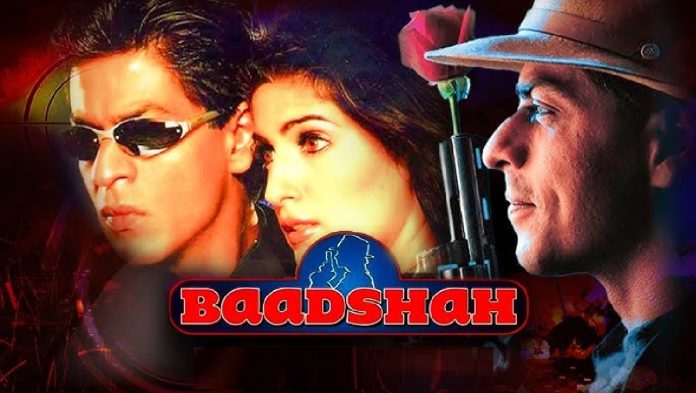BAADSHAH
Venus Records & Tapes Ltd.’s Baadshah (UA) is a thriller with comedy as its base. A private detective is mistaken for a CBI sleuth not just by the CBI team but also by the villains who are out to kill the actual sleuth. But, in fact, the private detective is on a mission to rescue a rich industrialist’s little daughter from her kidnappers. The gang of villains uses him as its pawn and sends him on a mission to kill a lady chief minister. Much as he would not like to commit the heinous crime, he finds himself in a helpless situation as the villains would blow up the little daughter of the industrialist if the private detective did not exterminate the lady. How the detective, with the aid of his friends, not only saves the chief minister and rescues the little girl but also succeeds in exposing and killing all the villains forms the climax.
The story is confusing and has too many tracks but all credit to the writers (Shyam Goel and Neeraj Vora) for doing a neat job of the screenplay. Yet, despite their best efforts, the audience does tend to get baffled because of so much confusion and misunderstanding between the characters (as required in the plot). The first half is comical and while some jokes are hilarious and mass-appealing, a few others are of the kind which can be enjoyed by the class audience only. The post-interval portion takes a comparatively serious turn and gets boring at places. The last part of the film has plenty of surprise elements but again, it has been stretched a great deal. The inspiration of the last few reels seems to have come from the Jackie Chan starrer, Rush Hour.
One major drawback of the story is that when it is shown that each and every one around the chief minister is keen to see her killed, why doesn’t just anybody actually kill her? Why force an innocent and unwilling guy (private detective) to do it? The coaxing would have made sense had one or two people, really close to the chief minister, not been part of the murder plot because then, the others would not want to risk being identified. But there’s nobody like that and one unimportant character, who could have fitted into the groove, is discarded from the scene immediately. Another drawback is excessive comedy and lack of action (except in the last part of the film). Songs, though good, are not of the hit genre. What’s more, several of the songs look and sound similar.
Shah Rukh Khan plays the private detective to perfection. He is a pleasure to watch in comedy scenes. He also dances well and comes out with flying clours in dramatic scenes. In one word, Shah Rukh is absolutely fantastic and lovable. Twinkle Khanna looks ravishing and also acts ably. Johny Lever is adorable as always and evokes laughter at several places. Amrish Puri does a fine job. Raakhee is restrained as the lady chief minister. Sachin Khedekar, as her husband, impresses. Deepshikha looks sexy and performs well. Sharat Saxena is effective. Pankaj Dheer leaves a mark. Saurabh Shukla is average and so are Neeraj Vora, Shashikala, Sudhir, Mahavir Shah, Adi Irani, Viju Khote and Charlie. Razzak Khan is good. Prem Chopra, Avtar Gill, Amrit Patel, Harpal and baby Karishma Jain lend able support. Deepak Tijori is good in a special appearance. Dinesh Hingoo provides a couple of good comic moments.
Abbas-Mustan once again prove that there is hardly anybody to match them as far as slickness and style in filmmaking go. Their direction is excellent but the same cannot be said of their choice of subject which holds more appeal for children and city audience. Dialogues are masterly at several places where they are witty and humorous. Choreography is eye-pleasing. Thomas A. Xavier’s camerawork deserves distinction marks. Locations look fabulous and so do the stars. Anu Malik’s music is above average but a film of such a canvas needed nothing but super-hit music. Action scenes are quite thrilling. Background score is effective. Production values are grandiose. Other technical aspects are brilliant.
On the whole, Baadshah will rule at the box-office in Bombay and South mainly. In the other circuits, a bumper initial will just about save the situation. Prospects in the Eastern circuit are weak.
Released on 27-8-’99 at New Excelsior and 20 other cinemas of Bombay thru V.I.P. Enterprises. Publicity & opening: extraordinary. …….Also released all over. Opening was bumper everywhere.
LATEST POSITION
The extraordinary opening of BAADSHAH this week and the general upsurge in collections on Thursday due to Raksha Bandhan holiday have brought all-round cheer.
Arjun Pandit has done very well in U.P., East Punjab and Rajasthan, from where overflow is assured. It is below the mark in Delhi and fair in other circuits. 1st week Bombay 58,02,892 (87.12%) from 13 cinemas (7 on F.H.); Ahmedabad 16,09,622 from 6 cinemas, Asodar 1,54,646, Baroda 1,90,296, Surat 1,29,122, Valsad (gross, 26 shows) 1,70,997, Bharuch (gross) 2,81,614, Vapi (gross) 3,63,812, Patan (gross) 2,10,157, Cambay 1,52,314, Jamnagar (matinee) 30,654, Adipur 1,49,890, Bhuj 1,16,102; Pune 12,22,536 from 5 cinemas (1 in matinee), Kolhapur 2,61,643, Solapur 4,31,019 from 2 cinemas; Delhi 44,67,961 (79.93%) from 9 cinemas (4 on F.H.); Kanpur 7,59,011 from 2 cinemas, Lucknow 4,39,391, Allahabad 2,95,425, Hardwar 2,12,042 (91.54%); Calcutta 22,96,248 from 16 cinemas; Nagpur 7,18,030 from 5 cinemas, Jabalpur (6 days) 1,45,348, Amravati (6 days) 1,93,920, Akola 1,71,400, Raipur (6 days, gross) 2,93,621, Bhilai 1,25,454 from 2 cinemas, Jalgaon (6 days) 1,84,358; Indore 3,65,411 from 2 cinemas (5 on F.H.), Bhopal 1,97,611 (1 unrecd.); Jaipur 10,40,036 from 3 cinemas, Bikaner 2,27,970 from 2 cinemas, Udaipur 3,48,700; Hyderabad (gross) 30,57,489 from 17 cinemas; Vijayawada (gross) 1,71,117.
Taal has maintained well in Bombay, Delhi and South. Is excellent in the USA and good in other parts of Overseas. Continues to be dull in the rest. 2nd week Bombay 61,80,501 (82.40%) from 11 cinemas (7 on F.H.); Ahmedabad 11,54,301 from 4 cinemas, Baroda 2,20,639, Padra 1,94,292, Valsad 2,07,394, Jamnagar 1,02,540; Pune 12,19,534 from 4 cinemas (1 in matinee), Solapur 1,67,656; Delhi 53,93,423 from 9 cinemas; Kanpur 2,89,511 from 2 cinemas, Varanasi 2,05,525, Allahabad 1,77,864, Bareilly 78,369, Hardwar 65,127 (21.43%); Calcutta 9,26,330 from 4 cinemas; Nagpur 3,44,219 from 2 cinemas, Jabalpur 89,120, total 2,50,522, Amravati 1,78,510, Akola 1,26,800, total 3,57,195, Raipur (gross) 2,70,722, Bhilai (gross) 1,81,458, total 4,57,180, Jalgaon 1,38,525 (1st 2,18,000), Chandrapur 1,14,242, total 3,20,189, 1st Yavatmal 1,08,937; 2nd week Indore 1,60,000 (2 on F.H.), Bhopal 99,227; Jaipur 6,23,825, Jodhpur 2,75,000 (1st 3,20,000), Ajmer 94,420 (1st 1,29,626), Bikaner (6 days) 82,237, Udaipur 2,89,880 (1st 3,31,200); Hyderabad (gross) 21,46,409 from 7 cinemas, share about 10,80,000, Aurangabad 2,77,506; Vijayawada (gross) 3,53,593, Visakhapatnam (gross) 3,03,075 from 2 cinemas, Kurnool (gross) 1,30,560, Cuddapah (gross) 1,12,198 from 2 cinemas, Ananthapur (gross) 1,51,188.
Kohram has crashed almost everywhere. 2nd week Bombay 29,22,909 (47.11%) from 13 cinemas (7 on F.H.); Ahmedabad 5,09,547 from 4 cinemas, Rajkot 1,52,830 from 2 cinemas (1 in matinee), Jamnagar 61,028 from 2 cinemas (1 in matinee); Pune 6,53,960 from 5 cinemas, Kolhapur 1,50,000, Solapur 1,42,483 from 2 cinemas; Delhi 12,43,947 from 8 cinemas; Kanpur 2,26,924 from 3 cinemas, Lucknow 3,34,766 from 3 cinemas, Varanasi 1,51,179, Allahabad 1,65,006, Bareilly (6 days) 37,239; Calcutta 6,55,135 from 5 cinemas; Nagpur 2,03,121 from 3 cinemas, Jabalpur (6 days) 61,470, Amravati (6 days) 1,59,784, Raipur (6 days) 86,905, Bhilai (6 days) 39,584, Jalgaon (6 days) 1,22,414, Yavatmal 79,745 (1st 1,75,585); Indore 69,441 (1 on F.H.); Jaipur 2,32,713 from 2 cinemas, Bikaner 1,07,605, Udaipur 1,92,835 (1st 2,18,600); Hyderabad (gross) 3,58,314 from 2 cinemas.
Hindustan Ki Kasam 5th week Bombay 5,23,249 (34%) from 5 cinemas (1 on F.H.); Ahmedabad 43,583 from 2 cinemas, Baroda (matinee) 14,664, Rajkot 48,400 from 2 cinemas (1 in matinee), Jamnagar (matinee) 6,439; Solapur 31,757; Delhi 1,32,780; Kanpur 45,021, Lucknow 63,894, Allahabad 28,577, Bareilly (6 days) 21,642; Nagpur 10,138, Jabalpur (6 days) 23,676, 1st week Gondia (6 days, gross) 1,02,275; 5th week Bhopal 20,000; Jaipur (24 shows) 65,193.
_____
Maa Te Maa Bija Wagda Na Waa (G., TF) 2nd week Ahmedabad 81,636 from 2 cinemas, poor, Rajkot 1,15,000.
MARATHI FILM ACTOR SURYAKANT MANDRE NO MORE
Veteran Marathi film actor Suryakant Mandre passed away in Pune on 22nd August following chest problems. He was 73 and is survived by his wife and three sons.
Beginning his career in Marathi films as a child actor in Dhruv (1938), Suryakant went on to act in over a hundred Marathi films. He was especially popular in the role of Shivaji Maharaj in several films including Bahirji Naik (1943), Jai Bhavani (1947), Ganimi Kava, Swarajyacha Shiledar (1951), Pavan Khind (1956) and others. His other memorable roles include that of a comedian in Amhi Jato Amuchya Gava (1968). In Kaul De Khanderaya, he was paired with his brother, Chandrakant.
“HONEST” SOLUTION!
Reacting to the article published in our issue last week under the caption ‘Film-Making Today — Overseas Market: Is Its Bigness Eclipsing Home Market?’, producer-director Rajkumar Santoshi remarked:
“The solution offered by you (Film Information) at the end of the article is incorrect. It is a regressive solution.” (We had said that the solution lay in making a HAHK..! or a DDLJ, which would click in Overseas as also in Bihar and the rest of India). The real solution, according to Santoshi, lies in being honest to oneself. He substantiated, “If a maker feels, his film caters to the tastes of audience in Overseas more than in, say, Bihar, he should be honest enough to sell the distribution rights for Bihar at a much smaller price. Why must he sell Bihar or another territory, in which the film may not be expected to fare well, at the high ratio fixed for other territories like Overseas? Let the makers be honest to themselves. Therein lies the solution.” Point noted, Mr. Santoshi!
“MAKE FILMS FOR OVERSEAS, NOT BIHAR”: BIPIN SAVLA
Reacting to our last week’s article, ‘Film-Making Today — Overseas Market: Is its Bigness Eclipsing Home Market?’, Bipin Savla, the associate producer of Raja Hindustani, asserts that films should henceforth be made for Overseas only, instead of keeping Bihar as the yardstick. His reasoning is based on the fact that even after Raja Hindustani proved a super-duper hit all over, the film’s Bihar distributor was ‘unable’ to share the overflow with the producer. “If a film like Raja Hindustani fails to get overflow from Bihar, no film can get overflow from there,” says Savla.
With business having gone into overdrive, Overseas is not the kind of territory it used to be. “Previously,” points out Bipin Savla, “Overseas used to be a subsidiary territory, sold on outright basis, but today, it is sold on MG royalty basis. On the other hand, producers used to sell Bihar on MG royalty basis, but today, the MG price of Bihar is as good as outright price.”
ANNOUNCEMENTS & LAUNCHINGS
Vashu Launches Film With Abhishek: A. Muthu Turns Director
Producer Vashu Bhagnani launched Puja Films’ Tera Jadoo Chal Gaya on the auspicious day of Raksha Bandhan (Aug. 26) with a song recording at Mehboob Recording Theatre. The song, penned by Sameer, was rendered (on 27th) by Sonu Nigam and Kavita Krishnamoorthy. Music was composed by Ismail Darbar.
Editor A. Muthu turns a director with this film to roll in September. Abhishek Bachchan has been signed for the lead role. A heroine and other cast are being finalised. Writers: Robin Bhatt and Ikram Akhtar. Dialogues: Javed Siddiqi.
YOU ASKED IT
Is it right to say that making a universal hit is becoming increasingly difficult?
– Not at all! Pick up a universally appealing subject, work on it very hard and make a film — you may have a universal hit on your hands. Today, only a few films are doing universally good business because there’s lack of sincerity on the part of the makers, generally speaking. The pursuit is to make big money (by selling the film at high ratios) more than a big hit. Besides, the territorial ratios need to be revised. Ratios of Bengal and C.P.C.I. Rajasthan need to be brought down.
What is the business of Marathi film Bindhast likely to be?
– About 1.5 crore — maybe, a little more also — from Bombay, Maharashtra, C.P. Berar and Marathwada.
Which has been the biggest success in West Bengal and Bihar so far this year?
– SOORYAVANSHAM and HOGI PYAR KI JEET respectively.
IN & OUT OF BOMBAY
Producer-director Govindbhai Patel, currently in Bombay at Cyrus Hotel (382-7215/1947), will leave for Baroda on 30th August.
Producer Boney Kapoor is in Hyderabad and will return on 30th August.
Producer S. Raamanathan left for Madras this afternoon (28th August).
Mr. R.N. Mandre of Mandre Pictures, Bangalore, is leaving for Kathmandu today (Aug. 28) and will be back in Bombay on the evening of 29th. On 1st Sept., he will leave for Venice to attend the Venice Film Festival for 4-5 days and then fly to London from there. He will be back in Bombay on 10th Sept.
DO YOU KNOW?
* After the failure of RAJAJI, Vimal Kumar has decided to take a break from direction for at least a year. Meanwhile, he is working on two projects that he will be producing simultaneously — one, to be directed by Kuku Kolhi, and the other, by Satish Kaushik.
* Juhi Chawla is making a special appearance in Raj Babbar’s Hindi-Punjabi bilingual, SHAHEED UDDHAM SINGH.
* Santosh Singh Jain has served as president of the Central Circuit Cine Association (CCCA) for a total of 32 years in the 46-year history of the Association. His first stint as president was from 1964 to 1969; second, from 1970 to 1982; and the present, which began in 1984.
* As a distributor, Mohanji Prasad has become active all over again after keeping a low profile despite the big success of DULHE RAJA in Bihar. He has now acquired five films for Bihar! His acquisitions are Boney Kapoor’s PUKAAR, Shyam Bajaj’s KAHIN PYAR NA HO JAYE, Salim Akhtar’s BADAL, Harmesh Malhotra’s ANKHIYON SE GOLI MAARE, Vijay Galani’s new film, and B. Subhash’s DULHAN BANOO MEIN TERI (the last-named film for South Bihar only).
* Subhash Ghai’s TAAL has been dubbed in Tamil as TAALAM.
3-E
Education-Entertainment-Enlightenment
Lot’s In A Name!
Talk about a movie living up to its name. Last week, the airing of Mehul Kumar’s Kohram on cable in Simla saw a widespread ruckus being created in the city by National Students Union of India activists. As a protest against the students’ vandalism, shops in the entire city remained closed on 21st August. The activists were protesting against depiction of a corrupt minister, played by Danny Denzongpa in the film, named Virbhadra Singh, as that also happens to be the name of the Congress leader and former chief minister of Jammu & Kashmir. As if this weren’t enough, Danny’s character is fondly referred to in the film as ‘Raja Saheb’ which, coincidentally, is also how the politician is generally addressed by the people. Thus when the film was being broadcast, a number of NSUI activists marched to the cable operator’s premises and went on a rampage, smashing equipment and beating up employees. At the end of it all, the premises of the cable operator, who showed Kohram, itself looked like a scene of kohram! May be Mehul Kumar’s next film will be called Shanti!
‘Star Wars’ Takes Europe By Storm On Debut
The European launch of Star Wars: Episode 1 – The Phantom Menace is an earth-shattering success, if its opening weekend collections in 27 territories all over Europe are anything to go by. Hitting the European screens 11 weeks after its premiere release, this George Lucas marvel has grossed US dollars 26,368,311 from 3,302 screens between August 19 and 22. Among the top-grossing European countries for the film are Austria (USD 1,373,325 from 110 screens), Denmark (932,403 from 66), Germany (12,437,889 from 1,001), Norway (889,637 from 73), Spain (4,306,674 from 352) and Sweden (1,616,025 from 100).
In Japan, where the film is currently running in its seventh week, it has registered a total collection of USD 79,870,663 so far. In UK, the film has grossed USD 67,922,394 in six weeks and is all set to surpass Jurassic Park as the third highest grossing film ever released in UK.
The total Overseas collections of Star Wars: Episode 1 – The Phantom Menace stand at USD 271,754,182, making it the highest grossing film of the year. Its U.S. box-office collections have crossed USD 417 million already.
Karisma Not Quitting….. Keep Quizzing!
Is Karisma Kapoor getting married? Is she not getting married? Is she quitting films? Is she not? Ever since Karisma walked out of Deepak Shivdasani’s Yeh Raaste Hain Pyaar Ke, these questions have dominated every discussion on films, whether in trade circles or non-trade circles. The answer to these questions is: Karisma is not quitting films because she has no plans to get married now. Why, the girl in demand has even signed one or two new films just recently. Which ones are they? No, no, their names can’t be revealed here. Let this new question now dominate the discussions on films — whether in trade or non-trade circles!
The Long & The Short Of It
One cannot doubt the intentions of those producers who make their films long. Perhaps, they sincerely intend giving ‘full value for money’ (FVM). But, of late, there have been films which have been described (by the trade as well as the audience) as being “too lengthy”. Some recent examples are International Khiladi, Mann, Hum Dil De Chuke Sanam, Taal and this week’s release, Baadshah (length: 4,929.47 metres).
Of course, there are examples of films, which despite being long, have never been dubbed “lengthy”. In fact, they have proved to be long-runners, like Sangam, Waqt, Sholay, Dulhan Wohi Jo Piya Man Bhaaye, Maine Pyar Kiya, Hum Aapke Hain Koun..! and even the Hollywood international blockbuster, Titanic.
Providing a stark contrast to the big ones, as is the current trend, is Hello Brother, the running time of which is only 2 hours and 15 minutes (length: 3,694.10 metres), which the exhibitors feel is “short, very short”.
One is apt to ask, “Then what should be the optimum length of a film? A veteran editor’s oft-repeated sermon to his assistants and directors used to be, “A film should be as long as it entertains. At the end of it, the viewers should wish for more”. That’s the long and short of it.
So Said Hitchcock
While on the topic of length of a film, it would not be out of place to recall Alfred Hitchcock’s humorous quote: “The length of a film should be directly related to the endurance of the human bladder.”
Obviously, he said this with reference to English films. Thank God, Hindi cinegoers have an interval to go to the toilet to empty their bladders!
Busybee Distributors
Mohan Chitra must be the busiest distributors not just in C.P. Berar but in the whole of India. The concern has in the last 2-3 months released in C.P. Berar Hum Dil De Chuke Sanam, Mann, Taal, Arjun Pandit, and Baadshah this week. Its forthcoming releases are 1947 Earth (10th September) and Dil Kya Kare (24th September). The deals would happily go on. Happy dealing!
Joke Of The Week
Since elections are round the corner, here is a true and timely incident that truly brings out music maestro Kalyanji’s vintage humour. Some years ago, someone asked him, “Why is it that more and more actors are standing for elections nowadays?” Kalyanji replied with a deadpan face, “That is because today, people want a government which can act.”! More humour Kalyanji ishtyle, next week.
ASHA PAREKH IS FULLY TO BLAME
Dear Sir,
This has reference to an article published in Film Information in the issue dated 21st August ’99 under the heading, ‘WHY BLAME ASHA PAREKH?’, which is totally misleading.
The writer has quoted various rules of the Cinematograph Act but is apparently not aware of the ground realities in the country where rules are only meant to be quoted for convenience, and, in actual practice, rules are bypassed to harass and torture those who don’t blindly toe your line. Can Asha Parekh explain why ever since she became the chairperson, every medium- and small-budget filmmaker has started getting nightmares at the very thought of getting his film censored. If she is not responsible, how is it that big films are censored in a matter of days whereas small films are held up for months, and the producer is tortured and harassed to such an extent that he has to reshoot and also submit revised versions before the high and mighty chairperson agrees to sign the certificate? Is it not a fact that the regional officer and assistant regional officers have clearly and categorically been instructed to make the passing of small-budget films impossible by appointing only such members on the examining committee as are known to be having views similar to those of the chairperson? I challenge the chairperson to prepare a chart of the passing of small-budget films and the whole world will come to know how the personal bias and prejudice of the chairperson is responsible for the torture and trauma of small-budget filmmakers.
The chairperson cannot deny that she is biased against such films because she has gone on record in her interviews to say that small-budget horror and sex films will not be passed in her tenure as they are anti-scientific, obscurantist, vulgar and against Indian culture. It is not at all surprising that the reason for refusal of certificates to nearly all the small-budget films in the letter of refusal is that the film has a thin storyline or that it is a crudely made film, unscientific, obscurantist and against Indian culture and values. I would like to know that if the denial of certificate is not as per the directions of the chairperson then how is the reason for denial the same for every picture? This not only speaks of lack of application of mind by the EC and RO but total bias of Ms. Asha Parekh. I want to know from her if Fire and Bombay Boys, having lesbianism and gay themes, are her ideas of Indian culture and values. As far as ‘unscientific’ and ‘obscurantist’ are concerned, it is apparent that Ms. Asha Parekh does not watch TV because millions of people watch ‘unscientific’ and ‘obscurantist’ material on all TV channels which are also viewed by children, but adult citizens of the country who vote and elect the government can’t see such films even after buying tickets. I would like to ask Film Information, how is it that no film was refused certificate on grounds of being unscientific and obscurantist before the unfortunate appointment of Ms. Asha Parekh? Moreover, in this case, how can it be said that she is not responsible?
Asha Parekh’s justification in the press for her action in banning small films is that some film was found with interpolation, but does she not realise that for one criminal, you cannot execute a full community? The laws of the country are very clear and if somebody commits a crime, the law will deal with him, and all producers cannot be penalised for the mistake of one.
I am very grateful to Mr. Shekhar Kapur and others because of whom the whimsical and illogical behaviour of the CBFC is out in the open and we can talk about it because so far, out of fear of persecution, the Indian filmmakers had no choice but to bear the humiliation like in my case where reference to ISI of Pakistan was cut in my film, Chote Nawab Bade Nawab, but Sarfarosh, based totally on ISI, was passed as it was a big film. Asha Parekh should realise that every film, whether big or small, is the maker’s dream and the Constitution of India gives the right of freedom of expression to every individual as also the producer, and the viewer has the right to see whatever he wants. Therefore, it is essential that the CBFC should just do its job i.e. certify films and not ban, cut films and try to change films and the society because its job is to certify films and not to be the moral guardian of the country.
– Naresh Mohnot
Proprietor
N.D.R. Productions,
Bombay.
SHOWBIZ TODAY
CITY PULSE: A DREAM SHOW PLACE
How often have you had to fight for getting space on the hand-rest of your chair in a cinema hall? Or how many times have you had to look with disgust at the gentleman sitting behind you in a dark cinema hall when he moved in his seat but, due to lack of enough leg space, kicked your seat or feet? Just how often have you tripped on the steps leading to the auditorium as you groped your way late into a cinema hall with all lights switched off? In the interval, how many times have you had to postpone visiting the toilet simply because you’d have to stand in a queue in a smelly toilet and, after the job is done, try to get water out of a dry tap which is part of a shaky wash-basin?
At City Pulse, the newly-started cineplex at Gandhinagar, the capital city of Gujarat, you encounter none of these problems. Every chair in all the three cinemas of the multiplex has a hand-rest on either side. The leg-space between the two rows of chairs is so much that one can push back his chair and yet not disturb the person in front of him. The stairs leading to the landing of the auditorium are all dotted with tiny bulbs which are kept lit for 15 to 20 minutes after a film starts, for the comfort of latecomers. As for the toilets — take that wrinkle off your nose — they don’t stink. The wash-basins have automated taps from which water flows as soon as one’s hands come under them. The flushes too work automatically.
It this isn’t customer care, there’s plenty more at City Pulse built on a huge expanse of land on the Sabarmati-Gandhinagar highway, a cool 20 to 25-minute drive from Ahmedabad city. The foyer for ticket bookings is of 4,000 sq, ft. and this leads to the cinema foyer which is about 6,500 sq. ft. in area and has a huge fish tank on one side. Three different kinds of lights adorn the ceiling of the foyer. Screens 1 and 2 are opposite each other on the ground floor and the 3rd screen is on the first floor. Wall-to-wall carpets in the cinemas, ultra-comfortable chairs with cold-drink holders, wide screens 65 ft. 55 ft. and 50 ft. in the three cinemas, Dolby digital and DTS sound systems, air-conditioning plants which are kept on throughout every show, all these make cinema viewing a pleasure at City Pulse. Little wonder then that despite being far away from the city, the cinema has been able to build a large and loyal clientele in a short span of a little over three months only. Of course, the distance from the city has its disadvantage too because the 12 noon and 3 p.m. shows are not heavily patronised. But the evening and night shows witness people flocking in large numbers in cars. Car parking, which is usually a cinegoer’s nightmare, is like a nice dream here — there’s parking space for 600 cars! Compare this with the combined seating capacity of the three screens — 1,240 — and you’d understand why car-parking is not a nightmare at City Pulse.
A common projection room caters to all the three screens and it is fully automated with minimal requirement for handling prints. A single print of Taal was screened in its release week in two screens of City Pulse with a difference of barely a minute between the screening time in the two cinemas. Christie’s projectors, auto rewinding facilities and the latest sound equipments make projection a left-hand task.
There’s a single class in all the three cinemas — Screen 1 has 566 seats, Screen 2 has 445 seats and Screen 3, 229 seats — and the ticket rate is uniform, Rs. 100. Each cinema also has separate boxes for VIPs. Yes, the cinema has become a sure spot for spotting VIPs on Saturday and Sunday evenings. For, as the popcorn packets sold at the cinema mention: ‘3 theatres and a picnic’. The whole experience at City Pulse is indeed like a picnic. Besides the beautifully done-up cinemas and immaculately maintained place, there’s a huge compound, in one corner of which is a food court that does brisk business. On another side of the compound, under a huge tree, there’s a live band playing music every evening — Hindi music on four days and English music on Fridays, Saturdays and Sundays. Visitors sit on paadars (stone platforms built around trees), listening to the live band, before the film begins and in the interval. There are water fountains in front of and behind the band, adding to the music. Lush green trees heighten the overall ambience of the place.
A bowling alley, a games parlour and a theme restaurant are under construction in the same premises. An amphitheatre and a conference room as well as 5-star rooms and green rooms for visiting artistes, singers and performers are also under-construction.
The first foyer has a huge wall with a collage of photographs of film stars. Made at a cost of Rs. 3.5 lakh, the collage attracts the attention of many a cinegoer.
The entire complex has cost owner Ashok Purohit many crores but an excellent policy of the Gujarat government makes it a viable business proposition. For ten years, there will be no entertainment tax and show tax on films screened at the cineplex, and no sales tax and turnover tax on eatables sold there. Electricity duty is also not leviable. Easy loans from financial institutions is another aid.
Purohit, it needs to be mentioned here, is himself a leading architect of Ahmedabad. His capabilities as a professional and his aesthetics are evident in every corner of the complex. What also comes to the fore is his concern for cinegoers. While any other businessman would have tried to cut down on wastage of space to make the proposition more economically viable, Purohit has done just the reverse. For example, while the rules provide for exit stairways of a breadth of 5 feet, his stairways are 7 and even 10 feet broad. The cinema exits are 2, 4 and 6 in the three screens in place of the 1, 2 and 3 respectively required by law. This is to ensure quicker exit of people in case of an accident like fire. Remember the infamous Uphaar cinema fire tragedy of 1997 in Delhi? Ashok Purohit has been helped in the designing by his daughter and son-in-law who, too, are architects. His second daughter, who is an interior designer, has done the interiors. Unbelievable as it may sound, the beautiful complex was up and running in just 15 months of its commencement. So well-designed and well-maintained is the cineplex that word has already spread in the industry. Little wonder then that the cinema has had exhibitors from places like Pune (Chaphalkar), Delhi, Nasik and Nagpur visiting it to design their planned multiplexes on similar lines. The incomplete part of the multiplex would be completed in a few months from now. Ashok Purohit’s wife looks after the day-to-day functioning and administrative side of the cineplex. Even before the screening of films started there on 7th May, 1999, the Purohits had organised a live performance of Daler Mehndi at the complex. Ila Arun too sang and danced at the show.
Not really a film man before this, Ashok Purohit was truly initiated into the idea of constructing an entertainment complex when he and his wife visited Universal Studios in Hollywood and saw Citywalk multiplex there. Fifty-five-year old Purohit is so happy with his first multiplex that he now plans to construct more such entertainment plazas in the years to come. He is already designing one with four screens in Nagpur for film financier N. Kumar.
Ashok Purohit, besides being a renowed architect, is also a deeply religious man. In fact, on one side of the cinema, there’s a huge lawn (not open to the public) with a small temple in one corner of it. Purohit points out to the idols of Lord Shiva and Sai Baba there and introduces them thus: “They are my partners in business. I don’t get the time to look after the affairs of the cineplex but I know, my God, my partners are taking care of it.”
Taking care of the bookings for the three screens is exhibitor Nandu Bohra. Purohit has only words of praise for Bohra’s business acumen and gives him a lot of credit for the success of City Pulse in the industry. A look at the table alongside will indicate what fabulous collections films at City Pulse have netted. For example, as against the 3-lakh share of Taal from Ahmedabad city in its first week, one print at City Pulse yielded a share of Rs. 11 lakh in 1 week! Even a film like Mann has yielded a share of Rs. 20 lakh from City Pulse in its 7-week run so far.
Shouldn’t the popcorn packets now read: ‘3 theatres and a picnic — and for distributors, a big pick!?’
– Komal Nahta





























